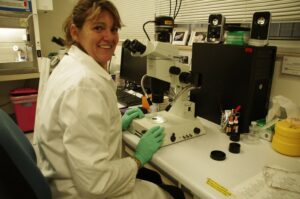
Job Title: Plant Pathologist
How did you choose your job? Or did it choose you? I finished my PhD in 2010 looking at endophytes in ryegrass and a position came available at the Australian Cotton Research Institute, Narrabri for a cotton pathologist. I immediately applied for it and was successful.
What does a typical day look like for you? A typical day for me starts with checking the whiteboard calendar in my office for tasks/experiments that are due. Catch up my technical assistant and technical officer to plan through the day and those following. Set up laboratory and or glasshouse/growth room experiments, record results then analyse the results. A lot of time is also spent on reading journal articles about pathogens of interest and any new breakthroughs.
How long have you worked in this area and what roles have you had previously? I have worked for NSW DPI as a plant pathologist since 2010. My research concentrated on cotton diseases and developing management strategies until 2019. Since then, I have been working as a hemp pathologist developing natural and or organic control strategies for the industrial hemp and medicinal cannabis industries. I am also working on a climate change project looking at the suitability of changing climates on the Verticillium dahliae pathogen.
What training/education have you received? When I first left high school, I studied aquaculture and worked on prawn farms and prawn hatcheries for about 12 years. Then I moved back to Narrabri. I had a few different jobs: a casual at the Australian Cotton Research Institute working for an entomologist, then I worked for a cotton seed company as a glasshouse technician before heading off to do my PhD. Whilst working for NSW DPI, I have received training on the job. In 2011 I was sent to Texas, USA on a scholarship to develop two National Diagnostic Protocols on high priority pests of cotton – Texas root rot and Bacterial blight. My research took me back to Texas in 2017 on a 4 week stay to collaborate with industry experts on cotton diseases. I have also attended several NPBDN Annual Diagnostic Workshops.
What is your greatest career achievement? I have had several, including diagnosing the first report of the exotic Verticillium dahliae defoliating strain VCG1A in Australian Cotton, the first report of Verticillium VCG6 in Noogoora burr and carrying out the research required to get SeroX (an organic product) registered for the control of Verticillium in cotton.
How do you see your role changing/improving in the next 2-4 years? My understanding of pathogens affecting industrial hemp and medicinal cannabis will increase thereby increasing my ability to develop control strategies. Having organic or natural products registered for disease management will increase the sustainability of these developing industries, but more importantly it will be safe for consumers. My role will continue as a researcher; however, I am also moving in the direction of being on more industry committees such as the IHemp NSW.
What advice would you give anyone starting or changing their career? Take every opportunity to develop your network and skills. Attend training whenever there is an opportunity and don’t be afraid to say you don’t know something. Know your own skills and capability gaps and work on those and the rest will come with experience.